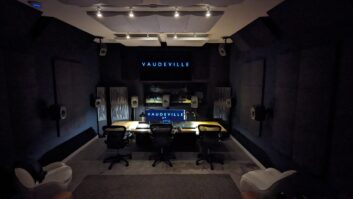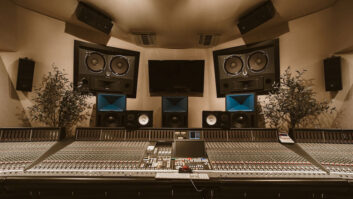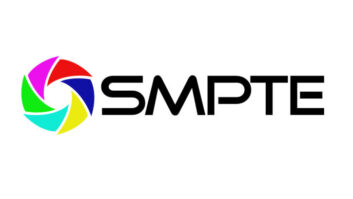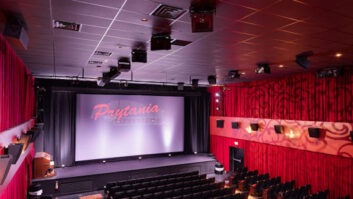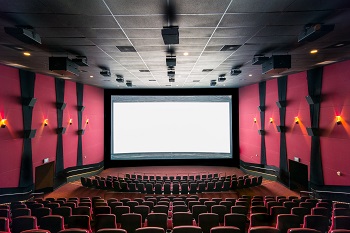
The introduction in 2005 of the Digital Cinema Initiatives standard brought with it the largest wholesale change in motion picture presentation since the arrival of widescreen cinema and stereophonic sound in 1953. It differed greatly from the past because picture and sound specifications had already been carefully vetted by committees with an eye toward scalability of the DCPs (Digital Cinema Packages) that are sent to theaters.
For the image, this meant 2k resolution was the minimum, but 4k was supported; in sound, all theaters were expected to have basic 5.1 systems, although the standard allowed for a total of 14 channels. Two additional channels are reserved for mono mixes for hearing impaired and visually impaired patrons, the latter being narration on top of the mix.
However, it was inevitable that variations would soon occur, and these were first in picture with various implementations of 3-D. As soon as this was starting to sort itself out in 2012, two different immersive sound formats arrived to break the 7.1 barrier that was the limit for almost all previous DCPs.
First, in January 2012 Auro Technologies, in association with Barco Cinema, introduced Auro-3D with the film Red Tails in Auro 11.1, which was shown in about two theaters in the U.S. The development of Auro-3D began seven years prior, with research that CEO Wilfried Van Baelen had done at his Galaxy Studios in Belgium.
The Auro-3D cinema format, in its basic 11.1 cinema iteration, adds a 5.0 height layer—three screen speakers and two upper surround channels— above the standard 5.1 system—plus a top layer comprising a center-ceiling “Voice of God” channel. The system can be expanded to 13.1 with the splitting of the lower surrounds into four channels, as in 7.1.
Utilizing their proprietary Auro Codec, the additional tracks are encoded in the four least significant bits of a standard 24-bit, 48kHz mix, so that only one 5.1 or 7.1 printmaster needs to be shipped on DCPs, with the additional height and top channels decoded in the cinema.
Auro Technologies has a complete suite of plug-ins to aid mixers, including the Auro-Panner, to place sounds in the 3-D field, and Auro- Matic Pro, which allows upmixing of mono, stereo and 5.1 elements to their 11.1 and 13.1 formats.
The second “salvo” in the new format wars occurred in June 2012 when Dolby Laboratories introduced its Atmos format for the Pixar animated film Brave on 14 screens. Dolby had been researching expanding cinema speakers for years, going back to 2002 and We Were Soldiers, which utilized an overhead VOG channel.
After years of experimentation with various speaker positions, including screen height as in Auro-3D, Dolby arrived at standards for surround speaker spacing, locations, and dispersion and mounting angles. The side surround speakers begin near the screen, and fill up the first third of the auditorium where normal surrounds are absent.

Timbre match of surrounds to screen channels is made a reality by employing bass management; this, combined with the placement of surrounds closer to the screen, helps smooth out the transition of sounds off the screen and by giving surrounds much increased power handling. Bass management is not used in all theaters; at Dolby’s screening room in Los Angeles and at the Samuel Goldwyn Theater at the Academy, the existing surrounds were able to go down to 40 Hz, which matches the specified low-end response of screen speakers. The final speakers added in Atmos are two overhead arrays down the length of the theater’s ceiling. Up to 64 speakers are supported by the CP-850 Atmos cinema processor, which went into production in April 2013; before that, theaters were using the studio RMU mastering unit.
OBJECT-BASED AUDIO
Where Auro-3D is its current form is channelbased in the classic stereo film manner, with recorded tracks assigned either to specific speakers or arrays of speakers, Atmos is objectbased. In object-based cinema audio, sounds are not necessarily dedicated to a specific channels for the length of program, but instead individual files are placed in the three-dimensional space of the theater via metadata containing level, location XYZ coordinates and start/stop times. (X is left-right across the screen, Y is from the screen to the back wall, and Z is height.)
Object-based audio (OBA) is of course the foundation of video games, in which the timing and location of sounds are variable according to where players are in their worlds. For movies, which occur in a linear fashion, OBA is used for two purposes: One, to pinpoint the location of a sound in what otherwise might have been an array (such as a surround theater wall) or a group of speakers (such as behind the screen) or in three-dimensional variations among arrays and speakers. Two, it allows for this accurate panning to take place in various theater configurations and sizes: “halfway down the right side wall” scales to the same position, regardless of whether the wall contains eight or four speakers.
Among the first public demonstrations of OBA for cinema were in the early part of the last decade by IOSONO, based on research done at the Fraunhofer Institute in Germany. IOSONO was shown in various venues in Los Angeles from 2008-2010, although current IOSONO efforts have primarily been in special venues and corporate events. [Editor’s Note: Iosono was purchased by DTS in October 2014.]
While Auro-3D is not currently object-based, their creative tools suite allows object-based mixes to be made, although it will not be in the same 5.1 or 7.1 PCM format as today. Also, the Barco cinema processors were designed with an upgrade path in mind, and 24 outputs, which presumably would allow the surrounds to be split into more zones.
Essentially, the goal will be for the metadata of any format’s mix to be seen by any cinema processor’s renderer, which is matched to the configuration file of a theater’s specific speaker layout. Indeed, back at the mix stage, there have been mixes that were originally made in Auro or Atmos that have had panning data modified for the other format. The difference to the public would be how much the theater’s system matches that of the mix stage.
One potential solution that has been presented is Multi-Dimensional Audio by DTS. The company, which was originally known for its double-system digital theatrical format, split in two in 2009, with DTS keeping the licensing of consumer software and codecs. (The theatrical business was spun off to a new company, Datasat, which coincidentally manufactures the AP24 processors for Barco on an OEM basis.)
While MDA has not been used on any films, it has been tested in the industry, and version 1.0 of the code was released in early August, following up on specifications submitted to the SMPTE Working Group on standardization, 25CSS, months earlier.
Object-based like Atmos, MDA is being offered to the industry as an open format, with an SDK available to developers. As an open format, MDA would be license-free, and DTS would make available necessary software for digital audio workstations and console manufacturers. (Auro Technologies and Dolby have been providing similar support to filmmakers.)
Unlike Auro and Atmos, whose basic philosophies demand specific, scalable speaker locations and aiming (with Dolby going a step further in components and EQ), MDA is, by design, speaker agnostic. Indeed, there will be presumably much leeway in its implementation in theaters. For example, USL has come up with a cost-effective way for cinemas to upgrade by rendering the MDA mix to 13.1 channels of PCM files “offline,” distributing those files to the media blocks of the servers in theaters. Rendering would take into account configuration files for individual cinemas.
TO THE HOME
Dolby and Auro Technologies have taken their first steps to get their immersive tracks in AV processors. Auro Technologies announced their own Auro-3D Auriga unit at this year’s CES show, and they have signed up McIntosh, Datasat and Lyngdorf, among other companies, to bring Auro-3D to the home.
Dolby’s serious push for Atmos at home began in August, with demonstrations around the U.S. to the consumer audio press. Atmos for home theaters is scaled down (from a maximum 64 speakers in theaters) to 24 floor speakers and 10 overheads. They expect that most homes will have no more than four overhead speakers, and Dolby has anticipated practical mounting issues by designing “Atmos enabled” speakers that fire up at the ceiling.
DTS will clearly be making a big push for MDA’s use in all media; donating it as an open, free format for cinema exhibition usage has to pay off some time. They and Dolby have dominated the licensing market for home theater audio for decades now.
[Editor’s Note: The following is excerpted from an article that originally appeared in the September 2014 issue of Mix, coinciding with the Sound for Film event at Sony Pictures Studios. For the author’s entertaining video presentation on a brief history of surround sound, visit mixonline.com.]
